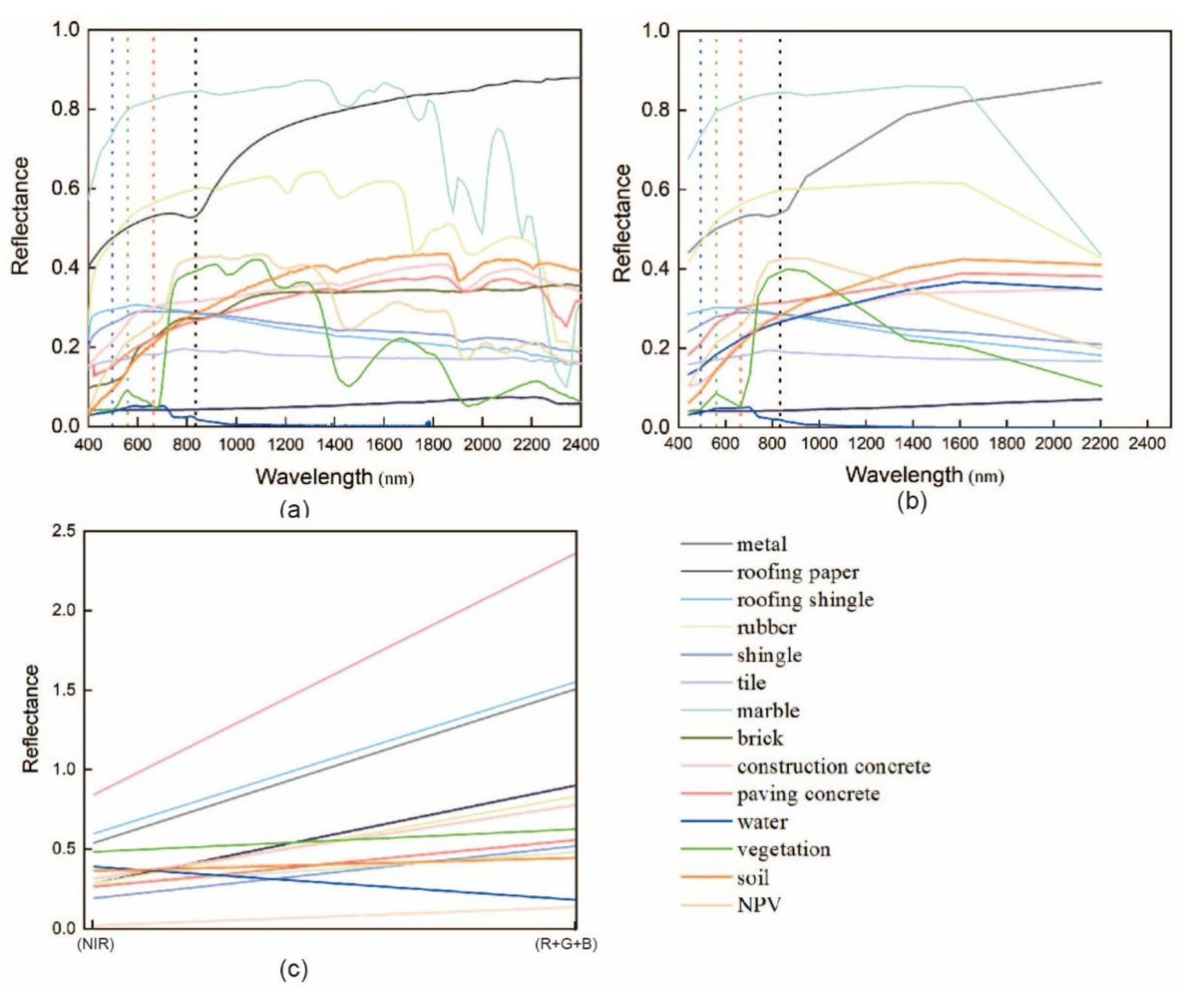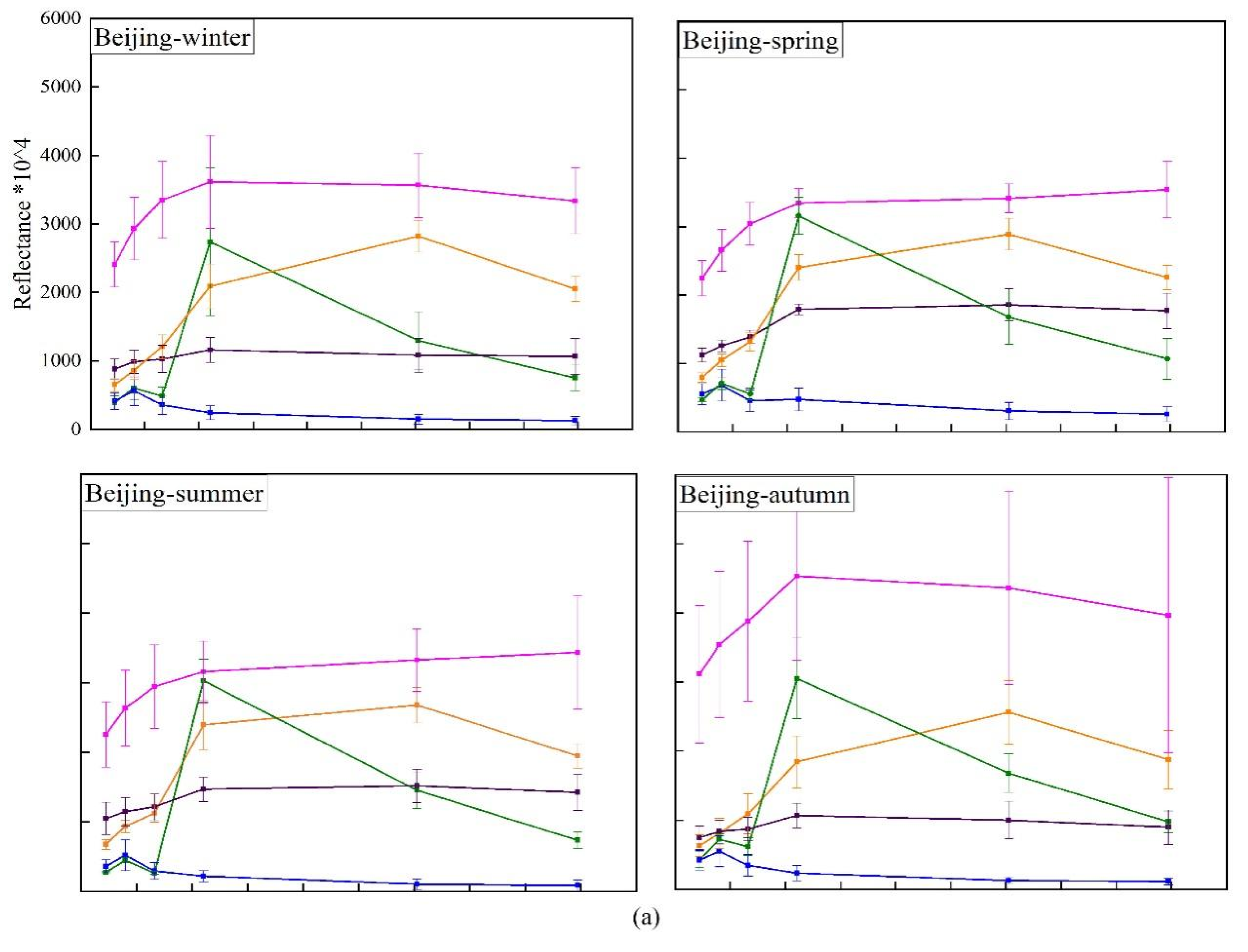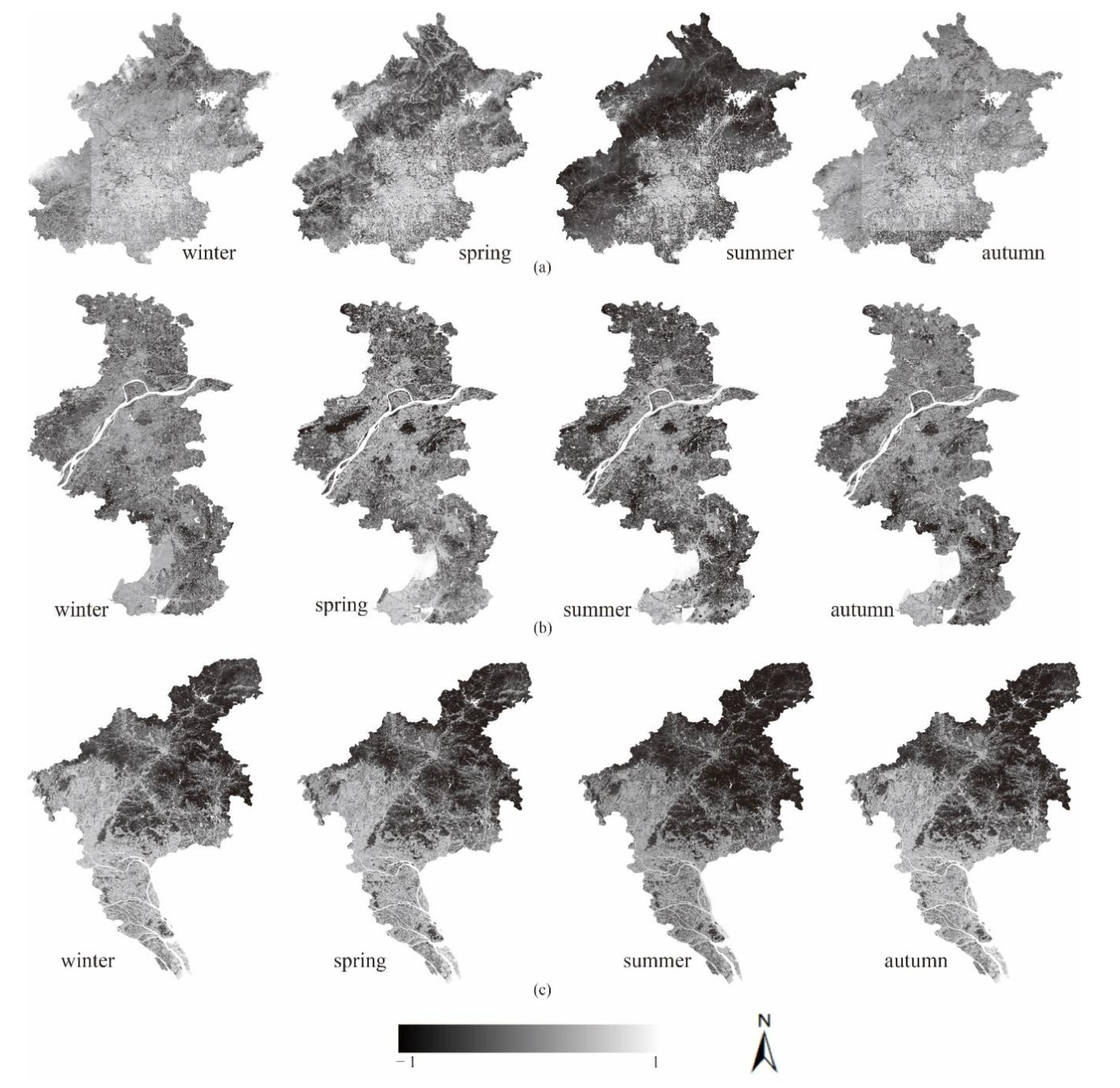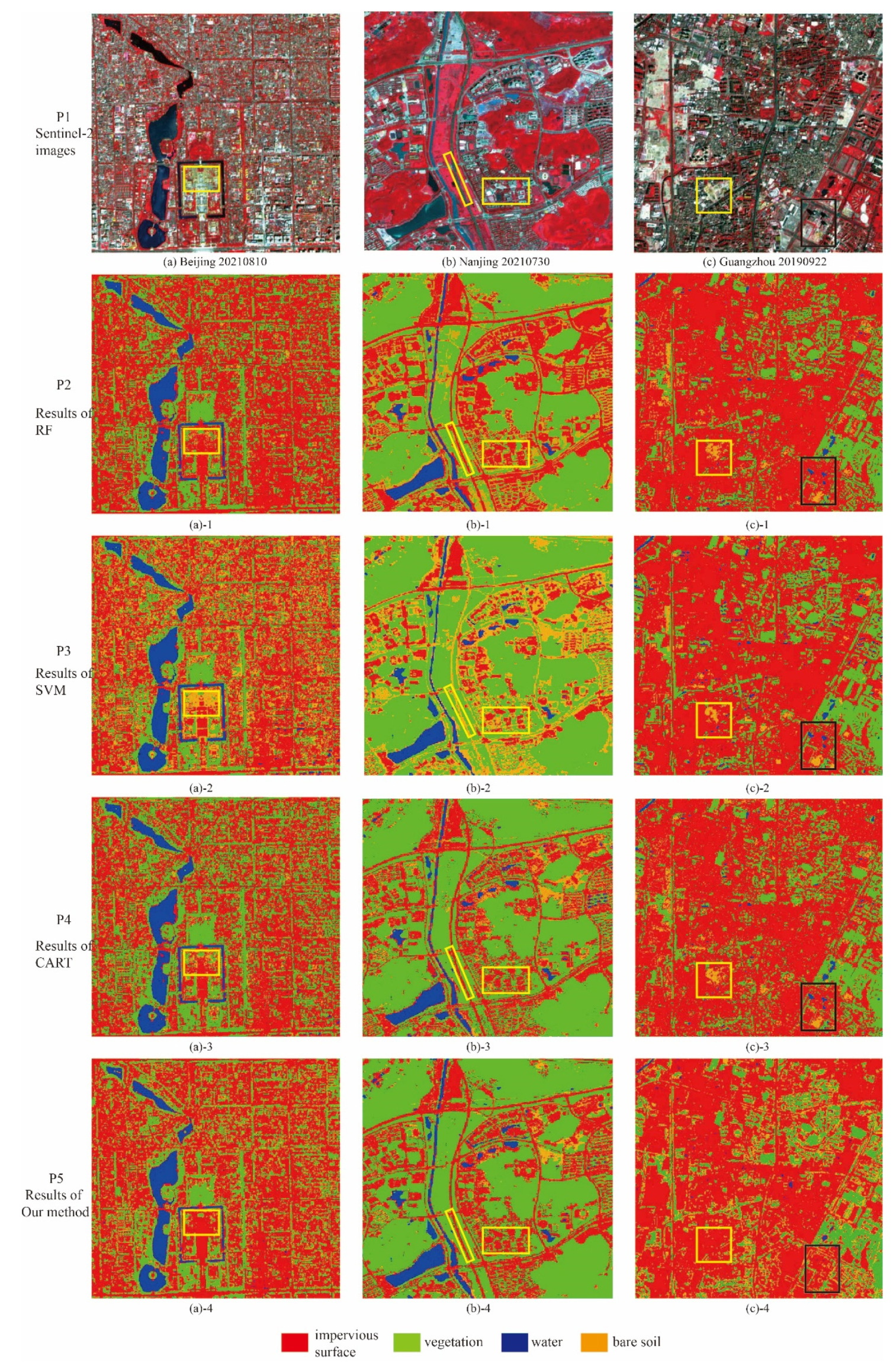An Impervious Surface Spectral Index on Multispectral Imagery Using Visible and Near-Infrared Bands
Abstract
:1. Introduction
2. Study Areas and Data
2.1. Study Area
2.2. Data and Pre-Processing
2.2.1. Remote Sensing Image Data
2.2.2. Laboratory Data
3. Methodology
3.1. Normalized Difference Impervious Surface Index (NISI)
3.1.1. Analysis of Spectral Reflectance Curves of Different Ground Objects
3.1.2. Spectral Analysis of Typical Objects within Urban Areas
3.1.3. The Development of NISI
3.2. Impervious Surface Mapping Based on NISI
3.3. Separability Analysis between Impervious Surface and Bare Soil
3.4. Accuracy Evaluation Method
4. Results
4.1. The Extraction of Impervious Surface Information via Index-Based Method
4.2. The Statistic Results of Separability Analysis
4.3. The Impervious Surfaces Extraction Results of Machine Learning Methods
5. Discussion
5.1. Influence Relationship between Separation of Bare Soil and Season Selection
5.2. Threshold Selection Strategy of NISI
5.3. Validation and Evaluation
6. Conclusions
6.1. The Advantages of NISI Model
- (1)
- The NISI was generated by using the spectral characteristic of world-recognized spectral libraries and Sentinel-2 MSI images in different areas and seasons. This index improved the identification of impervious and non-impervious surfaces. The NISI can be applied to various remote sensing images at different spectral and spatial resolutions, as the derivation of the NISI does not depend on SWIR and TIR wavebands.
- (2)
- A comprehensive comparison of other indices and machine learning algorithms ensured the correctness and effectiveness of the NISI model through qualitative and quantitative performance evaluation methods. Overall, compared to other existing methods for extracting urban impervious surface information, the NISI model demonstrated better performance. In this study, we selected three study areas with different latitudes, city clusters, and representations. The NISI as applied to remote sensing images of different spatial resolutions and showed strong generalization.
6.2. Limitations and Feature
Author Contributions
Funding
Data Availability Statement
Acknowledgments
Conflicts of Interest
Appendix A
| Reference | ||
|---|---|---|
| Classification | S = 1 | S = 0 |
| Y = 1 | TP (true positive) | FP (false positive) |
| Y = 0 | FN (false negative) | TN (true negative) |
References
- Weng, Q. Remote sensing of impervious surfaces in the urban areas: Requirements, methods, and trends. Remote Sens. Environ. 2012, 17, 34–49. [Google Scholar] [CrossRef]
- Arnold, C.L., Jr.; James Gibbons, C. Impervious Surface Coverage: The Emergence of a Key Environmental Indicator. J. Am. Plan. Assoc. 1996, 62, 243–258. [Google Scholar] [CrossRef]
- Weng, Q.; Lu, D. A sub-pixel analysis of urbanization effect on land surface temperature and its interplay with impervious surface and vegetation coverage in Indianapolis, United States. Int. J. Appl. Earth Obs. Geoinf. 2008, 10, 68–83. [Google Scholar] [CrossRef]
- Myint, S.; Brazel, A.; Okin, G.; Buyantuev, A. Combined Effects of Impervious Surface and Vegetation Cover on Air Temperature Variations in a Rapidly Expanding Desert City. Gisci. Remote Sens. 2010, 47, 301–320. [Google Scholar] [CrossRef]
- Kotarba, A.Z.; Aleksandrowicz, S. Impervious surface detection with nighttime photography from the International Space Station. Remote Sens. Environ. 2016, 176, 295–307. [Google Scholar] [CrossRef]
- Brun, S.E.; Band, L.E. Simulating runoff behavior in an urbanizing watershed. Comput. Environ. Urban Syst. 2000, 24, 5–22. [Google Scholar] [CrossRef]
- Zhuo, L.; Shi, Q.; Tao, H.; Zheng, J.; Li, Q. An improved temporal mixture analysis unmixing method for estimating impervious surface area based on MODIS and DMSP-OLS data. ISPRS J. Photogramm. Remote Sens. 2018, 142, 64–77. [Google Scholar] [CrossRef]
- Lambin, E.F.; Geist, H.J.; Lepers, E. Dynamics of land-use and land-cover change in tropical regions. Annu. Rev. Environ. Resour. 2003, 28, 205–241. [Google Scholar] [CrossRef] [Green Version]
- Sexton, J.O.; Song, X.P.; Huang, C.; Channan, S.; Baker, M.E.; Townshend, J.R. Urban growth of the Washington, D.C.-Baltimore, MD metropolitan region from 1984 to 2010 by annual, Landsat-based estimates of impervious cover. Remote Sens. Environ. 2013, 129, 42–53. [Google Scholar] [CrossRef]
- Herold, M.; Roberts, D.A.; Gardner, M.E.; Dennison, P.E. Spectrometry for urban area remote sensing—Development and analysis of a spectral library from 350 to 2400 nm. Remote Sens. Environ. 2004, 91, 304–319. [Google Scholar] [CrossRef]
- Wu, C. Normalized spectral mixture analysis for monitoring urban composition using ETM + imagery. Remote Sens. Environ. 2004, 93, 480–492. [Google Scholar] [CrossRef]
- Yang, J.; He, Y. Automated mapping of impervious surfaces in urban and suburban areas: Linear spectral unmixing of high spatial resolution imagery. Int. J. Appl. Earth Obs. Geoinf. 2017, 54, 53–64. [Google Scholar] [CrossRef]
- Okujeni, A.; van der Linden, S.; Tits, L.; Somers, B.; Hostert, P. Support vector regression and synthetically mixed training data for quantifying urban land cover. Remote Sens. Environ. 2013, 137, 184–197. [Google Scholar] [CrossRef]
- Ou, J.; Liu, X.; Liu, P.; Liu, X. Evaluation of Luojia 1-01 nighttime light imagery for impervious surface detection: A comparison with NPP-VIIRS nighttime light data. Int. J. Appl. Earth Obs. Geoinf. 2019, 81, 1–12. [Google Scholar] [CrossRef]
- Okujeni, A.; Canters, F.; Cooper, S.D.; Degerickx, J.; Heiden, U.; Hostert, P.; Priem, F.; Roberts, D.A.; Somers, B.; van der Linden, S. Generalizing machine learning regression models using multi-site spectral libraries for mapping vegetation-impervious-soil fractions across multiple cities. Remote Sens. Environ. 2018, 216, 482–496. [Google Scholar] [CrossRef]
- Sun, Z. Estimating urban impervious surfaces from Landsat-5 TM imagery using multilayer perceptron neural network and support vector machine. J. Appl. Remote Sens. 2011, 5, 053501. [Google Scholar] [CrossRef]
- Zhang, L.; Zhang, M.; Yao, Y. Mapping seasonal impervious surface dynamics in Wuhan urban agglomeration, China from 2000 to 2016. Int. J. Appl. Earth Obs. Geoinf. 2018, 70, 51–61. [Google Scholar] [CrossRef]
- Deng, C.; Wu, C. BCI: A biophysical composition index for remote sensing of urban environments. Remote Sens. Environ. 2012, 127, 247–259. [Google Scholar] [CrossRef]
- Liu, C.; Shao, Z.; Chen, M.; Luo, H. MNDISI: A multi-source composition index for impervious surface area estimation at the individual city scale. Remote Sens. Lett. 2013, 4, 803–812. [Google Scholar] [CrossRef]
- Sun, G.; Chen, X.; Jia, X.; Yao, Y.; Wang, Z. Combinational Build-Up Index (CBI) for Effective Impervious Surface Mapping in Urban Areas. IEEE J. Sel. Top. Appl. Earth Obs. Remote Sens. 2016, 9, 2081–2092. [Google Scholar] [CrossRef]
- Roberts, D.A.; Smith, M.O.; Adams, J.B. Green vegetation, nonphotosynthetic vegetation, and soils in AVIRIS data. Remote Sens. Environ. 1993, 44, 255–269. [Google Scholar] [CrossRef]
- Weng, Q.; Hu, X.; Liu, H. Estimating impervious surfaces using linear spectral mixture analysis with multitemporal ASTER images. Int. J. Remote Sens. 2009, 30, 4807–4830. [Google Scholar] [CrossRef]
- Zhao, Y.I.; Xu, J.; Zhong, K.; Wang, Y. Impervious Surface Extraction by Linear Spectral Mixture Analysis with Post-Processing Model. IEEE Access 2020, 8, 128476–128489. [Google Scholar] [CrossRef]
- Ridd, M.K. Exploring a V-I-S (Vegetation-impervious surface-soil) model for urban ecosystem analysis through remote sensing: Comparative anatomy for citiest. Int. J. Remote Sens. 1995, 16, 2165–2185. [Google Scholar] [CrossRef]
- Sun, G.; Chen, X.; Ren, J.; Zhang, A.; Jia, X. Stratified spectral mixture analysis of medium resolution imagery for impervious surface mapping. Int. J. Appl. Earth Obs. Geoinf. 2017, 60, 38–48. [Google Scholar] [CrossRef] [Green Version]
- Qin, Y.; Xiao, X.; Dong, J.; Chen, B.; Liu, F.; Zhang, G.; Zhang, Y.; Wang, J.; Wu, X. Quantifying annual changes in built-up area in complex urban-rural landscapes from analyses of PALSAR and Landsat images. ISPRS J. Photogramm. Remote Sens. 2017, 124, 89–105. [Google Scholar] [CrossRef] [Green Version]
- Li, W.; Dong, R.; Fu, H.; Wang, J.; Yu, L.; Gong, P. Integrating Google Earth imagery with Landsat data to improve 30-m resolution land cover mapping. Remote Sens. Environ. 2020, 237, 111563. [Google Scholar] [CrossRef]
- Esch, T.; Himmler, V.; Schorcht, G.; Thiel, M.; Wehrmann, T.; Bachofer, F.; Conrad, C.; Schmidt, M.; Dech, S. Large-area assessment of impervious surface based on integrated analysis of single-date Landsat-7 images and geospatial vector data. Remote Sens. Environ. 2009, 113, 1678–1690. [Google Scholar] [CrossRef]
- Reschke, J.; Hüttich, C. Continuous field mapping of Mediterranean wetlands using sub-pixel spectral signatures and multi-temporal Landsat data. Int. J. Appl. Earth Obs. Geoinf. 2014, 28, 220–229. [Google Scholar] [CrossRef]
- Deng, C.; Li, C.; Zhu, Z.; Lin, W.; Xi, L. Evaluating the impacts of atmospheric correction, seasonality, environmental settings, and multi-temporal images on subpixel urban impervious surface area mapping with Landsat data. ISPRS J. Photogramm. Remote Sens. 2017, 133, 89–103. [Google Scholar] [CrossRef]
- Xu, H. A new index for delineating built-up land features in satellite imagery. Int. J. Remote Sens. 2008, 29, 4269–4276. [Google Scholar] [CrossRef]
- Zha, Y.; Gao, J.; Ni, S. Use of normalized difference built-up index in automatically mapping urban areas from TM imagery. Int. J. Remote Sens. 2003, 24, 583–594. [Google Scholar] [CrossRef]
- Xu, H. Analysis of impervious surface and its impact on Urban heat environment using the normalized difference impervious surface index (NDISI). Photogramm. Eng. Remote Sens. 2010, 76, 557–565. [Google Scholar] [CrossRef]
- Wang, Y.; Li, M. Urban Impervious Surface Automatic Threshold Detection Model Derived from Multitemporal Landsat Images. IEEE Trans. Geosci. Remote Sens. 2022, 60, 1–21. [Google Scholar] [CrossRef]
- Xu, H.; Wang, M. Remote sensing-based retrieval of ground impervious surfaces. J. Remote Sens. 2016, 20, 1270–1289. [Google Scholar] [CrossRef]
- Lin, Y.; Zhang, H.; Lin, H.; Gamba, P.E.; Liu, X. Incorporating synthetic aperture radar and optical images to investigate the annual dynamics of anthropogenic impervious surface at large scale. Remote Sens. Environ. 2020, 242, 111757. [Google Scholar] [CrossRef]
- Carlson, T.N.; Ripley, D.A. On the relation between NDVI, fractional vegetation cover, and leaf area index. Remote Sens. Environ. 1997, 62, 241–252. [Google Scholar] [CrossRef]
- Jackson, H.; Prince, S.D. Degradation of non-photosynthetic vegetation in a semi-arid rangeland. Remote Sens. 2016, 8, 692. [Google Scholar] [CrossRef] [Green Version]
- Demetriades-Shah, T.H.; Steven, M.D.; Clark, J.A. High resolution derivative spectra in remote sensing. Remote Sens. Environ. 1990, 33, 55–64. [Google Scholar] [CrossRef]
- Tsai, F.; Philpot, W. Derivative analysis of hyperspectral data. Remote Sens. Environ. 1998, 66, 41–51. [Google Scholar] [CrossRef]
- Li, W.; Guo, Q. A New Accuracy Assessment Method for One-Class Remote Sensing Classification. IEEE Trans. Geosci. Remote Sens. 2014, 52, 4621–4632. [Google Scholar] [CrossRef]
- Zhang, X.; Li, P. Lithological mapping from hyperspectral data by improved use of spectral angle mapper. Int. J. Appl. Earth Obs. Geoinf. 2014, 31, 95–109. [Google Scholar] [CrossRef]
- Guo, X.; Li, P. Mapping plastic materials in an urban area: Development of the normalized difference plastic index using WorldView-3 superspectral data. ISPRS J. Photogramm. Remote Sens. 2020, 169, 214–226. [Google Scholar] [CrossRef]
- Nedkov, R. Orthogonal transformation of segmented images from the satellite sentinel-2. C. R. L’Academie Bulgare Des. Sci. 2017, 70, 687–692. [Google Scholar]
- Radeloff, V.C.; Mladenoff, D.J.; Boyce, M.S. Detecting Jack Pine Budworm Defoliation Using Spectral Mixture Analysis. Remote Sens. Environ. 1999, 69, 156–169. [Google Scholar] [CrossRef]
- Deng, Y.; Wu, C.; Li, M.; Chen, R. RNDSI: A ratio normalized difference soil index for remote sensing of urban/suburban environments. Int. J. Appl. Earth Obs. Geoinf. 2015, 39, 40–48. [Google Scholar] [CrossRef]
- Thomas, I.L.; Ching, N.P.; Benning, V.M.; D’Aguanno, J.A. A review of multi-channel indices of class separability. Int. J. Remote Sens. 1987, 8, 331–350. [Google Scholar] [CrossRef]
- Kailath, T. The Divergence and Bhattacharyya Distance Measures in Signal Selection. IEEE Trans. Commun. Technol. 1967, 15, 52–60. [Google Scholar] [CrossRef]
- Kaufman, Y.J.; Remer, L.A. Detection of Forests Using Mid-IR Reflectance: An Application for Aerosol Studies. IEEE Trans. Geosci. Remote Sens. 1994, 32, 672–683. [Google Scholar] [CrossRef]
- Pereira, J.M.C. A comparative evaluation of NOAA/AVHRR vegetation indexes for burned surface detection and mapping. IEEE Trans. Geosci. Remote Sens. 1999, 37 Pt 1, 217–226. [Google Scholar] [CrossRef]
- Gong, P.; Liang, S.; Carlton, E.J.; Jiang, Q.; Wu, J.; Wang, L.; Remais, J.V. Urbanisation and health in China. Lancet 2012, 379, 843–852. [Google Scholar] [CrossRef]
- Philpot, W.; Jacquemoud, S.; Tian, J. ND-space: Normalized difference spectral mapping. Remote Sens. Environ. 2021, 264, 112622. [Google Scholar] [CrossRef]
- Song, X.P.; Sexton, J.O.; Huang, C.; Channan, S.; Townshend, J.R. Characterizing the magnitude, timing and duration of urban growth from time series of Landsat-based estimates of impervious cover. Remote Sens. Environ. 2016, 175, 1–13. [Google Scholar] [CrossRef]
- Liu, C.; Zhang, Q.; Luo, H.; Qi, S.; Tao, S.; Xu, H.; Yao, Y. An efficient approach to capture continuous impervious surface dynamics using spatial-temporal rules and dense Landsat time series stacks. Remote Sens. Environ. 2019, 229, 114–132. [Google Scholar] [CrossRef]
- Deng, C.; Zhu, Z. Continuous subpixel monitoring of urban impervious surface using Landsat time series. Remote Sens. Environ. 2020, 238, 110929. [Google Scholar] [CrossRef]
- Xie, S.; Liu, L.; Zhang, X.; Yang, J. Mapping the annual dynamics of land cover in Beijing from 2001 to 2020 using Landsat dense time series stack. ISPRS J. Photogramm. Remote Sens. 2022, 185, 201–218. [Google Scholar] [CrossRef]
- Zhang, Y.; Zhang, H.; Lin, H. Improving the impervious surface estimation with combined use of optical and SAR remote sensing images. Remote Sens. Environ. 2014, 141, 155–167. [Google Scholar] [CrossRef]
- Yoo, C.; Im, J.; Park, S.; Quackenbush, L.J. Estimation of daily maximum and minimum air temperatures in urban landscapes using MODIS time series satellite data. ISPRS J. Photogramm. Remote Sens. 2018, 137, 149–162. [Google Scholar] [CrossRef]
- Aguirre-Gutiérrez, J.; Rifai, S.; Shenkin, A.; Oliveras, I.; Bentley, L.P.; Svátek, M.; Girardin, C.A.J.; Both, S.; Riutta, T.; Berenguer, E. Pantropical modelling of canopy functional traits using Sentinel-2 remote sensing data. Remote Sens. Environ. 2021, 252, 112122. [Google Scholar] [CrossRef]
- Angiuli, E.; Trianni, G. Urban mapping in Landsat images based on normalized difference spectral vector. IEEE Geosci. Remote Sens. Lett. 2013, 11, 661–665. [Google Scholar] [CrossRef]
- Wu, W.; Li, Q.; Zhang, Y.; Du, X.; Wang, H. Two-Step Urban Water Index (TSUWI): A new technique for high-resolution mapping of Urban Surface Water. Remote Sens. 2018, 10, 1704. [Google Scholar] [CrossRef] [Green Version]
- Leinenkugel, P.; Esch, T.; Kuenzer, C. Settlement detection and impervious surface estimation in the Mekong Delta using optical and SAR remote sensing data. Remote Sens. Environ. 2011, 115, 3007–3019. [Google Scholar] [CrossRef]
- Gong, P.; Li, X.; Wang, J.; Bai, Y.; Chen, B.; Hu, T.; Liu, X.; Xu, B.; Yang, J.; Zhang, W.; et al. Annual maps of global artificial impervious area (GAIA) between 1985 and 2018. Remote Sens. Environ. 2020, 236, 111510. [Google Scholar] [CrossRef]
- Zhang, X.; Liu, L.; Wu, C.; Chen, X.; Gao, Y.; Xie, S.; Zhang, B. Development of a global 30m impervious surface map using multisource and multitemporal remote sensing datasets with the Google Earth Engine platform. Earth Syst. Sci. Data 2020, 12, 1625–1648. [Google Scholar] [CrossRef]







| Study Area | Season | Data | Acquisition Time | Cloud Coverage (%) | Product Level |
|---|---|---|---|---|---|
| Beijing | Winter | 16 February 2021 | 03:08:11 | 6.24 | L2A |
| Spring | 2 May 2021 | 03:05:39 | 1.75 | L2A | |
| Summer | 10 August 2021 | 03:05:49 | 0.58 | L2A | |
| Autumn | 13 November 2020 | 03:09:59 | 1.01 | L2A | |
| Nanjing | Winter | 20 February 2021 | 02:47:31 | 0.51 | L2A |
| Spring | 1 May 2021 | 02:45:41 | 0.88 | L2A | |
| Summer | 30 July 2021 | 02:45:51 | 1.19 | L2A | |
| Autumn | 7 November 2020 | 02:49:19 | 0.40 | L2A | |
| Guangzhou | Winter | 1 December 2019 | 03:01:01 | 2.53 | L2A |
| Spring | 30 January 2020 | 02:59:41 | 3.20 | L2A | |
| Summer | 22 September 2019 | 02:55:41 | 3.38 | L2A | |
| Autumn | 21 November 2019 | 03:00:21 | 2.87 | L2A |
| Band Name | Wavelength (nm) | Central Wavelength (nm) | Bandwidth (nm) | Spatial Resolution (m) |
|---|---|---|---|---|
| Band 2 (Blue) | 458–523 | 496.6 | 65 | 10 |
| Band 3 (Green) | 543–578 | 560.0 | 35 | 10 |
| Band 4 (Red) | 650–680 | 664.5 | 20 | 10 |
| Band 8 (NIR) | 785–900 | 835.1 | 115 | 10 |
| Band 11 (SWIR-1) | 1565–1655 | 1613.7 | 90 | 20 |
| Band 12 (SWIR-2) | 2100–2280 | 2202.4 | 180 | 20 |
| City | The Classes of Land Cover | Winter | Spring | Summer | Autumn |
|---|---|---|---|---|---|
| Beijing | Water | 0.6932 | 0.6235 | 0.6674 | 0.6561 |
| Impervious surface | 0.3902 | 0.3728 | 0.4139 | 0.3872 | |
| Bare soil and NPV | 0.1931 | 0.1012 | 0.0054 | 0.2042 | |
| Vegetation | −0.0253 | −0.3234 | −0.4206 | 0.0204 | |
| Nanjing | Water | 0.7544 | 0.6968 | 0.7031 | 0.7357 |
| Impervious surface | 0.3052 | 0.3418 | 0.3637 | 0.3316 | |
| Bare soil and NPV | 0.0826 | 0.0858 | 0.0875 | 0.1390 | |
| Vegetation | −0.1593 | −0.3222 | −0.3376 | −0.1582 | |
| Guangzhou | Water | 0.7468 | 0.7599 | 0.7759 | 0.7689 |
| Impervious surface | 0.4464 | 0.4234 | 0.4258 | 0.4433 | |
| Bare soil and NPV | 0.2381 | 0.2232 | 0.1992 | 0.2206 | |
| Vegetation | −0.3846 | −0.3788 | −0.4391 | −0.4211 |
| Method | NISI | NDBI | BCI | UI | IBI |
|---|---|---|---|---|---|
| SDI | 1.524 | 1.025 | 0.952 | 0.526 | 1.103 |
| TD | 1.928 | 1.712 | 1.701 | 1.254 | 1.724 |
| B-distance | 1.462 | 1.328 | 1.257 | 1.141 | 1.423 |
| Method | RF | SVM | CART | NISI | ||||||||
|---|---|---|---|---|---|---|---|---|---|---|---|---|
| Land-Cover Type | UA (%) | PA (%) | AA (%) | UA (%) | PA (%) | AA (%) | UA (%) | PA (%) | AA (%) | UA (%) | PA (%) | AA (%) |
| Impervious | 89.74 | 86.54 | 88.14 | 83.12 | 89.81 | 86.15 | 84.51 | 89.82 | 87.16 | 92.11 | 90.8 | 91.46 |
| Vegetation | 93.51 | 92.25 | 92.88 | 91.93 | 94.29 | 93.11 | 86.78 | 92.84 | 89.81 | 96.11 | 94.23 | 95.17 |
| Water | 92.54 | 95.41 | 93.97 | 87.56 | 93.14 | 90.35 | 89.73 | 91.58 | 90.66 | 91.52 | 92.58 | 92.05 |
| Soil | 72.13 | 68.32 | 70.22 | 71.42 | 66.27 | 68.84 | 64.84 | 62.85 | 78.84 | 80.47 | 79.86 | 80.16 |
| OA (%) | 84.26 | 83.39 | 81.49 | 89.28 |
| Method | RF | SVM | CART | NISI | ||||||||
|---|---|---|---|---|---|---|---|---|---|---|---|---|
| Land-Cover Type | UA (%) | PA (%) | AA (%) | UA (%) | PA (%) | AA (%) | UA (%) | PA (%) | AA (%) | UA (%) | PA (%) | AA (%) |
| Impervious | 86.28 | 88.69 | 87.48 | 85.28 | 84.76 | 85.02 | 87.42 | 82.59 | 85.00 | 89.68 | 87.29 | 88.48 |
| Vegetation | 91.23 | 95.27 | 93.25 | 92.46 | 93.76 | 93.11 | 90.28 | 91.48 | 90.88 | 93.24 | 91.65 | 92.44 |
| Water | 90.08 | 91.47 | 90.78 | 93.75 | 92.46 | 93.10 | 93.27 | 91.75 | 92.51 | 94.26 | 91.75 | 93.00 |
| Soil | 70.25 | 66.27 | 68.26 | 73.49 | 69.49 | 71.49 | 74.12 | 72.86 | 73.49 | 77.48 | 75.29 | 76.38 |
| OA (%) | 83.21 | 85.38 | 84.74 | 88.96 |
| Method | RF | SVM | CART | NISI | ||||||||
|---|---|---|---|---|---|---|---|---|---|---|---|---|
| Land-Cover Type | UA (%) | PA (%) | AA (%) | UA (%) | PA (%) | AA (%) | UA (%) | PA (%) | AA (%) | UA (%) | PA (%) | AA (%) |
| Impervious | 88.77 | 85.71 | 87.24 | 87.52 | 88.18 | 87.85 | 84.62 | 88.67 | 86.64 | 90.24 | 91.19 | 90.72 |
| Vegetation | 91.93 | 94.29 | 93.11 | 92.54 | 90.89 | 91.71 | 90.28 | 91.48 | 90.88 | 93.68 | 94.52 | 94.1 |
| Water | 91.54 | 94.52 | 93.03 | 94.74 | 91.82 | 93.28 | 93.27 | 91.75 | 92.51 | 93.75 | 94.26 | 94.00 |
| Soil | 71.75 | 68.86 | 70.30 | 72.92 | 73.59 | 73.26 | 74.12 | 72.86 | 73.49 | 76.75 | 78.94 | 77.84 |
| OA (%) | 85.74 | 84.29 | 83.63 | 89.59 |
| Method | RF | SVM | CART | NISI | ||||
|---|---|---|---|---|---|---|---|---|
| Land-Cover Type | UA (%) | PA (%) | UA (%) | PA (%) | UA (%) | PA (%) | UA (%) | PA (%) |
| Impervious | 88.26 (±1.457) | 86.98 (±1.256) | 85.31 (±1.796) | 87.58 (±2.104) | 85.52 (±1.347) | 87.23 (±3.172) | 90.68 (±1.039) | 89.76 (±1.754) |
| Vegetation | 92.22 (±0.954) | 93.94 (±1.258) | 92.31 (±0.271) | 92.98 (±1.494) | 89.11 (±1.645) | 91.93 (±0.641) | 94.34 (±1.262) | 93.47 (±1.290) |
| Water | 91.39 (±1.010) | 93.8 (±1.687) | 92.02 (±3.177) | 92.47 (±0.539) | 92.09 (±1.669) | 91.69 (±0.080) | 93.18 (±1.190) | 92.86 (±1.044) |
| Soil | 71.38 (±0.812) | 67.82 (±1.116) | 72.61 (±.873) | 69.78 (±2.996) | 71.03 (±4.375) | 69.52 (±4.719) | 78.23 (±1.609) | 78.03 (±1.974) |
| OA (%) | 84.40 (±1.038) | 84.35 (±0.814) | 83.29 (±1.349) | 89.28 (±0.258) | ||||
| Winter | Spring | Summer | Autumn | |
|---|---|---|---|---|
| Beijing | 1.2022 | 1.7664 | 1.8648 | 1.9601 |
| Nanjing | 1.2607 | 1.8690 | 1.9928 | 1.8098 |
| Guangzhou | 1.3489 | 1.1906 | 1.1468 | 1.1670 |
Publisher’s Note: MDPI stays neutral with regard to jurisdictional claims in published maps and institutional affiliations. |
© 2022 by the authors. Licensee MDPI, Basel, Switzerland. This article is an open access article distributed under the terms and conditions of the Creative Commons Attribution (CC BY) license (https://creativecommons.org/licenses/by/4.0/).
Share and Cite
Su, S.; Tian, J.; Dong, X.; Tian, Q.; Wang, N.; Xi, Y. An Impervious Surface Spectral Index on Multispectral Imagery Using Visible and Near-Infrared Bands. Remote Sens. 2022, 14, 3391. https://doi.org/10.3390/rs14143391
Su S, Tian J, Dong X, Tian Q, Wang N, Xi Y. An Impervious Surface Spectral Index on Multispectral Imagery Using Visible and Near-Infrared Bands. Remote Sensing. 2022; 14(14):3391. https://doi.org/10.3390/rs14143391
Chicago/Turabian StyleSu, Shanshan, Jia Tian, Xinyu Dong, Qingjiu Tian, Ning Wang, and Yanbiao Xi. 2022. "An Impervious Surface Spectral Index on Multispectral Imagery Using Visible and Near-Infrared Bands" Remote Sensing 14, no. 14: 3391. https://doi.org/10.3390/rs14143391
APA StyleSu, S., Tian, J., Dong, X., Tian, Q., Wang, N., & Xi, Y. (2022). An Impervious Surface Spectral Index on Multispectral Imagery Using Visible and Near-Infrared Bands. Remote Sensing, 14(14), 3391. https://doi.org/10.3390/rs14143391





